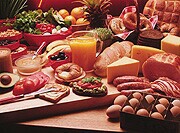Do what’s necessary to make nutrient-rich foods palatable, pediatricians say
MONDAY, Feb. 23, 2015 (HealthDay News) — New recommendations from the American Academy of Pediatrics emphasize the importance of introducing children to a wide variety of whole foods — from fruits and vegetables, to whole grains and nuts, to fish and low-fat dairy. And to do that, parents need to make the foods palatable, according to the authors of a policy statement published online Feb. 23 in Pediatrics.
And while it’s important to limit processed foods — often high in sugar, salt, or fat — parents shouldn’t focus solely on cutting “bad” things from their children’s diets, Robert Murray, M.D., a professor of human nutrition at Ohio State University in Columbus and coauthor of the academy recommendations, told HealthDay. If the only milk a young child will drink is flavored milk, for example, the extra sugar might be worth it — as long as the child’s overall diet has limits on sugary foods, according to the academy recommendations.
Similarly, if a dash of brown sugar gets your child to eat oatmeal, or a little salt and fat — such as vegetable oil or cheese — will encourage him to eat vegetables, then parents shouldn’t be afraid to use them, Murray said. “Think of sweeteners, fat, salt, and spices as ways to make nutrient-rich foods more palatable to children,” he said.
The organization’s advice is sound, Wesley Delbridge, R.D.N., told HealthDay, a registered dietitian and spokesperson for the Academy of Nutrition and Dietetics. “A whole-diet approach is where it’s at,” Delbridge said, who also encouraged patience. “It takes an average of 12 exposures to a new food for a child to accept it,” he said. “Don’t get discouraged if your child doesn’t like something the first time. Try again, try it with different cooking techniques.” Sitting down to dinner as a family is also key, Delbridge added.
Murray serves on speakers’ bureaus for the National Dairy Council and the American Dairy Association.
Copyright © 2015 HealthDay. All rights reserved.








